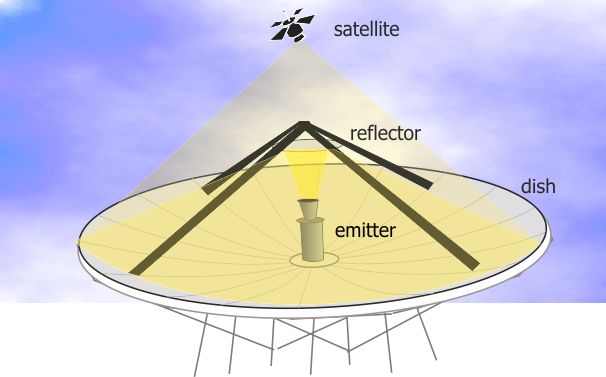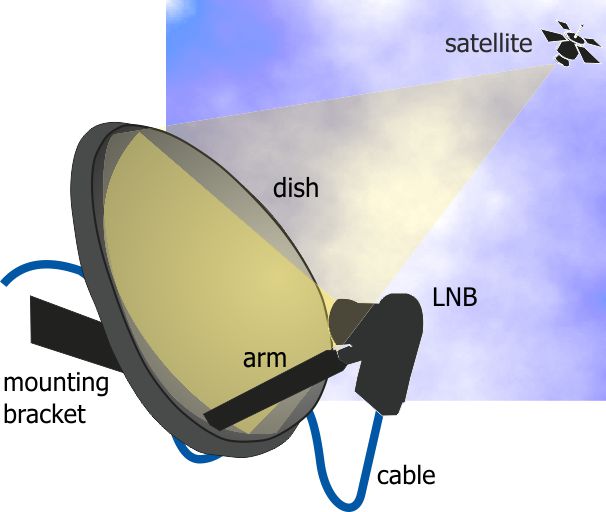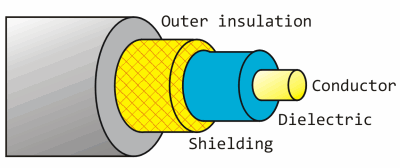Freesat reception - all about dishes
 Brian Butterworth published on UK Free TV
Brian Butterworth published on UK Free TV Satellite reception has both advantages and disadvantages compare with terrestrial (aerial) reception.
By using much higher frequencies (gigahertz, compared to terrestrial televisions megahertz) more transmission channels called transponders (the satellite equivalent of multiplexes) can be provided. For example, there are only six Freeview multiplexes, but Sky or Freesat users can access two hundred satellite transponders.
Aside from exceptional weather conditions (very heavy rain for example) digital satellite provides stable pictures and audio. Where Freeview transmitters are no more than 732 metres above sea level, the geostationary satellites used for television are 35,800,000 metres above the equator so reception is possible even where buildings, trees and hills make terrestrial reception impossible.

The downside of the transmitters being 22,300 miles up in the air is that the signals are very, very weak - so standard TV aerial is of little use. When the signals are sent to the satellites, huge dish transmitters are used to uplink the signal to the satellite. These are tens of metres from side to side, and feature an emitter that generates the signal, which is first bounced of a mirror (called a reflector) and then off the surface of the parabolic dish.

There are many satellites in the sky over the equator. Often these are in clusters over a particular position, for example there are four used for UK television are at 28.2 degrees east. There is another cluster over the 19.2 degrees east positions that are used for German television.
To receive these very weak signals from the satellite, it is necessary to use a dish for reception too. By using a reflective dish, this concentrates the signals onto a small device called a LNB. This is held in front of the dish by a metal arm.

The size of dish for reception is typically much smaller; often 60cm to 100cm in diameter, but the exact size depends upon the transmitting satellite transponder. To keep the transmission power levels down to levels that can be powered by the satellite's solar panels, each beam is focused on a particular area of the Earth's surface. If you are trying to receive the signal at the centre of this zone, a small dish is required. At the outer edges, you may need a 5 metre dish. Maps of these zones are provided by the satellite companies, and are called satellite footprints.
When the dish is installed it must be aligned carefully as the signal is very weak. The installer needs to know the inclination and the azimuth from the ground location to the satellite. If you install yourself you will find that there are markings on the dish that are used to point the dish in the correct position. It is important that the view of the satellite will not be blocked, so must take into account leaves growing on trees and potential building works.
For many people the LNB will have a single cable connected to it, however if you have Sky+ or a multi-room installation the LNB package will actually contain four receivers a quad-LNB. Unlike terrestrial television where you can split the aerial cable to feed more than one Freeview box or television set, with satelite reception you cannot. So, a Sky+ box with two receivers (so you can watch one thing and record another) has two cables connecting the box to the dish.
The cable that connects the dish to the receiver must be satellite grade cable. Whilst this looks superficially like the cable used to connect and aerial to a television, a higher grade cable is required for satellite reception.
Here is an image of a co-axial cable. This sort of cable is used to connect any type of receiving aerial to the reception equipment.

RG6, PF100 and PH100 are all types of coax cable that are suitable for the very weak signals that are received by a satellite dish. (The power is the same as you would receive from a one-bar electric heater on the moon).
The conductor in the centre passes the signals received from the dish to the set-top box. This is made from steel in RG6 cable, and from copper in the RF100 and PH100 types. This makes RG6 less suitable in the UK where rain can damage the cable.
The shielding is responsible for keeping unwanted external interference from damaging the signal. In the cheaper cable this will be a foil wrap, in better specified cables this is a braid (or mesh) of copper wires. The sheild in the RF100 covers 58% of the cable.
The non-conducting layer between the shield and the conductor is called the dielectric. This can be either a solid (RG6), foam (RF100) or air-spaced (PH100) dielectric. This makes the cables progressively more flexible (ie bendy without damage).
8:02 AM
Jean: You can still record with one lead but will not be able to view any programme other than the one being recorded, so if you set a programme to be recorded and its on a different channel / polarity the recording will be cancelled.
That said, you should see three connector points at the rear of your box, and what's generally done as a temporary measure to allow the viewing of a different channel (so long as same polarity) is to link the socket marked "RF out" across to the No2 dish input, as this allows both tuners to operate thereby getting over the problem.
If you link the two sockets mentioned you will generally have to go into the set up menu / dish inputs / and set it for that type of operation otherwise the second socket will not be recognised.
The only permanent way around this is to have a dual, or preferably quad, LNB fitted on the dish and a new cable run from it into the house, LNB's being under £10.00 from numerous e-bay sources and are simplicity to fit.
| link to this comment |
9:50 PM
Hi, I recently moved into a house, 3 bedrooms and the kitchen have TV points in the wall. I have been in the loft and discovered an 8 way philex slx8 amp/splitter. Tried following the cable into the input of this splitter but not sure where this is going.
Also the previous owners left the sky dish up on the back wall with the cable coming into the loft, but I cannot see what this is connected to.
I purchased a USB DBV-T stick for my pc and connected a coxial cable from the wall into this stick, but could not get any channels coming through. Having said that I used the portable antenna that came with the USB stick and that worked fine up to a point.
A friend of mine has lent me his BUSH freesat box which I connected to a spare TV, running the cable from the wall socket into the LNB in of the box, all I am getting is No Signal.
Any ideas what the problem is?
| link to this comment |
Superkool: I would have a look at Freeview signals: too much of a good thing is bad for you | ukfree.tv - independent free digital TV advice .
| link to this comment |
3:26 PM
Hi, anyone know how I can get Austrian/German TV in the UK. Was getting it on an old Amstraad Analogue box and dish but that has given up the ghost, will a free sat box allow me to get these channels.
| link to this comment |
9:31 AM
Germany is switching to digital-only.
You can replace your old analog box with any
basic digital one to get all the free-to-view
programmes in standard definition. HD requires
an HD box - and subscription to get most of the HD channels. Ihre Suchmaschine bemuehen, um mehr Infos zu finden!
| link to this comment |
10:15 AM
Superkool: It is possible that the dish was connected to a Sky box, a UHF tv aerial was connected to the RF in of the Sky box and the RF out of the Sky box was fed to the slx8 for distribution to the aerial points. You really need to find out what the dish is connected to (if anything!) and also find out if there is a UHF aerial in place. The Freesat box will only work with a dish connected directly to its input, and since there is likely to be no internal RF modulator you will have to view the output via a scart lead connected to your chosen tv. Connecting a UHF TV aerial directly to the UHF input of the slx8 will then provide a Freeview signal at each of the aerial points.
| link to this comment |
3:06 PM
every time it gets windy we get poor reception especially on BBC1 and BBC2. During calm conditions reception is perfect. I have removed a tree in our garden that I thought might be the culprit, but we still have the same problem. There is a neighbours tree about 50 yards away that might be in line, but otherwise it should be clear. Any suggestions? (the satellite was installed about 4 years ago and seems to be firmly in place and was trouble free until about a year ago).
| link to this comment |
5:20 PM
Paul: If you stand as directly under the satellite dish as you can manage and look forwards / upwards at an angle of approximately 25 degrees or so from the horizontal, then that's roughly the angle the signal is approaching the dish from.
If no obstructions are seen anywhere near this line then its likely that the dish is very slightly misaligned off centre (in the left / right horizontal sense) meaning that the slightest movement is upsetting the signal.
| link to this comment |
4:04 PM
can you tell me if there are poor reception areas for "built in" free sat TV's. I live in area CT9 and this is known as a poor area for reception of TV, Are there areas which are reknowned for having poor reception and can they be found by entering post code "on line".Havve not found a site yet
| link to this comment |
Linda Campbell: You'll be absolutely fine, Linda! The satellite is a little like a torch shining down at the ground. In the center of the beam the light is usually brightest, and it's a little dimmer towards the edges. The target area of the Astra Satellite is called the 'foot print', and most of the UK is well inside the foot print, enabling the small dishes to be used that you see on most house.
So unless your house is surrounded by tall trees or buildings to stop the signal getting to your dish you won't have any problems. If the people living around you have dishes on their houses, all will be well for you.
Out of interest, there is an area of Leeds, in West Yorkshire, that's notorious for poor satellite reception, but the problem is caused by microwave beams which cut right across the area on the way to a communications tower.
| link to this comment |